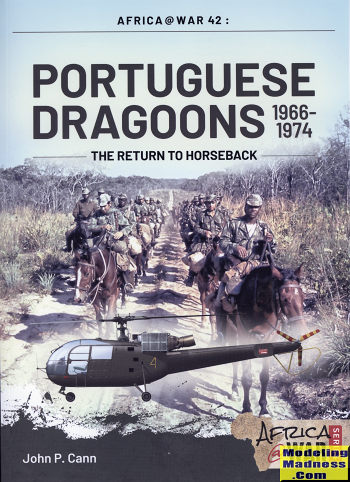 In the
Portuguese military, there has been a long history of light cavalry. This
continued up until WWII, when it was realized that modern cavalry was becoming
mechanized. Like most nations, Portugal went from horses to halftracks and other
vehicles. However, a long, successful history of mounted cavalry was one that
died hard.
In the
Portuguese military, there has been a long history of light cavalry. This
continued up until WWII, when it was realized that modern cavalry was becoming
mechanized. Like most nations, Portugal went from horses to halftracks and other
vehicles. However, a long, successful history of mounted cavalry was one that
died hard.
During the 1960s, most of Europen powers were divesting
themselves of their empires, either by peaceful transition or by revolutions.
Portugal was a nation that in an of itself was no longer a wealthy nation and so
needed the income of its African possessions in Angola and in Mozambique. It was
inevitable that the rise of insurgency in the African continent of the 60's
would eventually hit those two possessions and so they did.
Portugal was not well equipped to fight an insurgency
(or any major military action for that matter), but was determined to not let
the situation get out of hand. Most of the trouble was in Angola, though
certainly there was unrest in Mozambique as well. In addition, the Portuguese
tended to be fairly successful in stifling the situation in major population
areas; not so much in the more sparsely populated areas. These latter places
were ones where mechanized military would not be very useful due to the terrain.
Something had to be done.
One of the ideas was to re-introduce horse cavalry.
Horses were able to handle the terrain where vehicles would break down a lot,
were faster than foot soldiers, and were a lot less expensive than mechanized
cavalry. So the idea gained traction and the build up of mounted cavalry began.
To say it was successful would be an understatement. The ability of the
soldiers, many of whom were local and used to caring for livestock, surpassed
initial expectations and eventually were able to drive the fairly poorly
organized insurgents out of the country. The same was tried in Mozambique, but
the results were very different for a variety of reasons, mostly having to do
with the inability to train local soldiers.
The author has provided us with a background history of
the cavalry in Portugal along with the plans and build-up of forces in Angola.
The opposing sides are also covered, which is one of the strong point of this
particular series of books, for we get a good idea of how well (or not), their
leadership and planning worked out. When you add in a lot of great photos as
well as the usual color profiles, you have a book that really is a lot more
interesting than it seems when you start reading. A great addition to this
popular series and one I can quite easily recommend to you.
March 2020
Copyright ModelingMadness.com
Review book courtesy of
Casemate Publishing, where you can order your copy
at this
link.
If you would like your product reviewed fairly and quickly, please
contact
me or see other details in the
Note to
Contributors.
 In the
Portuguese military, there has been a long history of light cavalry. This
continued up until WWII, when it was realized that modern cavalry was becoming
mechanized. Like most nations, Portugal went from horses to halftracks and other
vehicles. However, a long, successful history of mounted cavalry was one that
died hard.
In the
Portuguese military, there has been a long history of light cavalry. This
continued up until WWII, when it was realized that modern cavalry was becoming
mechanized. Like most nations, Portugal went from horses to halftracks and other
vehicles. However, a long, successful history of mounted cavalry was one that
died hard.